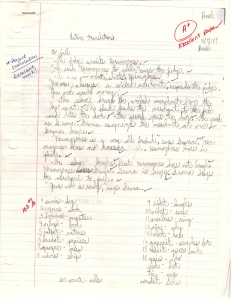Old Yellow Albatross
Ladies and Gentlemen of the Past-Dwellers, I present to you at right evidence Exhibit A+. What you’re seeing is not a recreation. This is an actual Latin translation done by your editor in 6th Grade at Georgetown Day School–Hannah Harrison building, November 19, 1987. In case it’s blurry, the upper right corner has an A+, amended with “Excellent Paper,” and at left it says, “Perfect translation/Excellent Work!” At the time it must have felt great to leave my teacher, Michal, so impressed. I mean, could just anyone have remembered that “quoque” meant also? I no doubt enjoyed bringing it home, where it somehow managed to stay in my collection for the next 23 years. Oh, but do you see what this really is above, ye Ancient Mariners of the Special Seas. This is an old yellow albatross!
It’s a yellow, faded, non-fluffy albatross. It was comforting to feel that I could get something perfect. That if I really studied and followed the steps, used my flashcards and memorized verb conjugations, I could get such a glowing result (Did you notice there’s a “100%” in the bottom left? I don’t think I mentioned that above). And these yellow albatrosses collect over the years. Maybe it’s that drawing on your fridge. Maybe it’s a piano competition award or tennis trophy. Maybe it’s a plaque for high achievement at work. Whatever they are they’re starting to take over your house, and, if you’re like me, settle themselves down in your mind to roost.
The problem with an A+ paper or other achievement token, is that when we try new things now, we still want to get the same praise. We are frightened school kids who still want to get that A+ so badly! I was carefully taught, in sequence, beginning Latin, and I knew exactly what would be on this test. There’s no one to teach you anymore how to use Photoshop or sync your contacts with your Droid, mostly because no one actually knows how to do these things. There are no teachers. We are all students, and there are the Special students, us, and then a different type– those who fearlessly try and try until they get it. Fearless Failers we’ll call them. These people are not Special. Learning to them isn’t precious. It’s filled with missteps that are then factored into making better choices. They don’t approach new things afraid. Yes, we’re very jealous of these people, but we can also learn from them!
In this Wired article from Oct. 4, Jonah Lehrer breaks down the differences in how people learn from their mistakes—why some are good at learning from them, and some not. The idea is that there are two major reactions when one makes a mistake, measurable by brain waves. One is the error-related negativity (ERN). It happens involuntarily 50 milliseconds after the error, and basically says, “Oops, I screwed up.” The second is error positivity (Pe), 100-500 milliseconds after a mistake, which means you’re aware of the mistake and trying to correct it. The idea is that if you register a big ERN, or realization, and consistent Pe, desire to change course, you will be a much stronger learner than if you try to ignore your mistake. I would only add, though, one more response for Special people: the OhNo Methinks I’m Failing Ginormously response (OMFG), registered anywhere from 500 milliseconds to twenty-five years after the mistake. The OMFG basically says I’m horrified I made that mistake, I’m not as smart as I used to be, my brain might be physically deteriorating, and I’ll very likely fail the LSAT/shelf-hanging/audition.
Lehrer also describes the work of Carol Dweck, who had students take simple tests and then gave them one of two lines of praise: either “You must be smart at this” or “You must have worked really hard.” When students were then offered the choice between two subsequent tests to take, one easier and one harder, the difference between those two lines of praise stunned even Dweck. Says Lehrer, “When kids were praised for their effort, nearly 90 percent chose the harder set of puzzles. However, when kids were praised for their intelligence, most of them went for the easier test. What explains this difference? According to Dweck, praising kids for intelligence encourages them to “look” smart, which means that they shouldn’t risk making a mistake.” Duh! Telling kids they’re smart is one of the cruelest things you can do to a child!
We have a hundred albatrosses that flutter around us, telling us why we’re not going to be good at what we’re doing. But there is good news! The good news is that every time we find a way to ignore past success or praise, to live in the moment and silence the past-dweller, an albatross loses its wings! Much more on that to come. For now, I leave you with my revised “Great Latin Translation test of 1987.” I’m sure you’ll recognize what type of big, yellow bird now crowns it. I was looking at google images of one when I drew so it should be accurate. Did I mention I love to draw? Do you think it’s good? Sorry#%?!!

